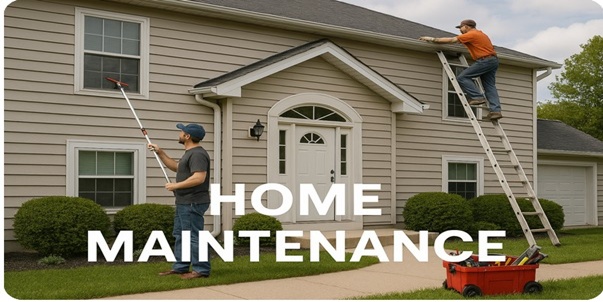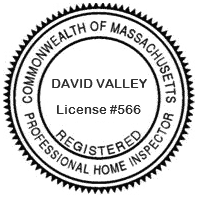Massachusetts Home Inspections YOUR INVESTMENT IS MY CONCERN

Home Maintenance

Your Massachusetts home is one of the most significant investments you'll ever make, so it's essential to take steps to care for it properly. A well-maintained home tends to sell faster and usually commands a higher price when it's time to put it on the market. Regular upkeep not only enhances the comfort of your living space but also helps minimize unexpected repair costs that might arise if maintenance is neglected. By staying on top of small, routine repairs and continuously upgrading your home, you can prevent maintenance costs from escalating.
The maintenance schedule I'm providing here is a general guide for you to follow. The timing for each task is flexible and can be adjusted based on your personal preferences. You may want to break down the seasonal maintenance tasks into smaller monthly chunks, so they don't interfere with your daily routine. Let's get started and ensure your home and its components stand the test of time!
WINTER
Clean or replace your furnace air filters every other month during the heating season. Regularly inspect the outdoor vents (intake and exhaust) to ensure they are clear of snow or debris. Inside the home, vacuum all heating supply registers, return grills, baseboards, or radiators to keep the system running efficiently.
After reviewing your hot water tank owner's manual, carefully test the temperature and pressure relief valve to ensure it isn't stuck. Caution: This test may release hot water, which can cause burns, and could also result in a slow leak if sediment buildup prevents the valve from sealing properly. In that case, you'll need a plumber to replace the TPR valve. Additionally, sludge may accumulate at the bottom of the tank. To check for this, drain about 1 gallon of water from the clean-out spigot at the bottom of the tank. If sludge is present, regular draining is necessary to control sediment buildup and maintain efficiency. Always remember to turn off the power or fuel supply before draining water from the tank.
Clean the humidifier (if equipped with one), two or three times during the winter season.
Vacuum the bathroom fan grille and any other registers in your home. It's a good idea to remove the register grilles and vacuum inside the ductwork (as far as you can reach). Also, vacuum all fire and smoke detectors, as dust or spider webs can interfere with their operation. Don't forget to dust any ceiling fan blades as well.
Vacuum radiator grilles on back of refrigerators and freezers, and empty and clean the drip tray underneath the refrigerator.
Check inside bathroom vanities and kitchen sink cabinets for signs of moisture. Inspect the shut-off valves under sinks, toilets, laundry equipment, and the main water shut-off valve for any leaks. Carefully examine pipes for condensation or slow drips. If needed, repair the plumbing system.
Remove mineral deposits from faucet aerators and shower heads by soaking the parts in white vinegar and scrubbing them with an old toothbrush.
Examine attic for frost accumulation. Check roof for ice dams or ice build-up. If either of these occur, this is a sign of inadequate insulation and/or ventilation.
Inspect all electrical cords, plugs, and outlets for indoor and outdoor seasonal lights to ensure fire safety. If any cords are worn or plugs or cords feel warm to the touch, replace them immediately. Test all ground-fault circuit interrupter (GFCI) outlets by pressing the "test" button— the "reset" button should pop out, indicating proper operation. Press the reset button to restore it. Additionally, check the AFCI circuit breakers in the main panel by pressing the test button to ensure they trip, then reset them.
FALL
Have all heating and cooling systems inspected by a qualified service professional once a year, or as per the manufacturer's warranty and service recommendations. Failing to follow the recommended maintenance schedule may void the warranty.
FURNACE: Inspect the forced air furnace fan belt for signs of wear, looseness, or unusual noise. Clean the fan blades of any dirt buildup (after disconnecting the power to the motor). Next, clean any dirt and dust from around the air grills and ducts. Open the furnace humidifier damper and clean the humidifier (if equipped). Hire a licensed HVAC technician to inspect the thermostat, electrical components, and controls; check the heat exchanger, flue, airflow, and air-fuel mixture; adjust the burner; and oil the motor and circulating fan. The exhaust pipe should also be checked for loose or corroded sections. Have your ducts cleaned every 5 to 6 years to keep your furnace clean and extend its lifespan. Ensure exposed ductwork is free of cracks or leaks, and seal seams with aluminum tape where necessary.
BOILER: Bleed air from hot water radiators to ensure efficient heating. Older circulating pumps should be lubricated twice during the heating season. Drain expansion tanks annually to maintain proper system function. Inspect the heat shield, located where the burner enters the heat exchanger, to ensure it is secure and free of corrosion. Burn marks around the heat shield or soot on the front may indicate a draft or combustion issue—if detected, contact a professional technician for further inspection.
OIL FURNACES AND BOILERS: Have oil heating systems inspected annually by a qualified technician. Oily soot deposits at forced-air registers may indicate a cracked heat exchanger—if present, contact a technician immediately. Check the exhaust pipe from the furnace or boiler for loose connections or corrosion, ensuring the barometric damper rotates freely. Clear any debris from the chimney cleanout and inspect the oil tank for leaks. Soot on the front of the furnace or boiler may signal a draft or combustion issue, requiring professional attention.
Paint interior rooms while it's still warm enough to leave windows open. Ditto for shampooing or replacing carpets.
Remove window air-conditioning units and store them. If they are not removable, cover them with plastic to protect them over the winter.
Check smooth functioning of all windows and lubricate as required. For single pane widows, remove or replace all screens with storm windows. Examine all hardware and locks on windows and doors, and lubricate moving parts. Each exterior door should have a one-inch deadbolt lock for safety.
All yard care power equipment should be drained of fuel in the late fall or early winter and serviced according to manufacturer's instructions.
Cover outdoor furniture or store it inside a shed.
Clean and repair garden equipment after its final use of the season. Remove dirt and rust, then store tools in a dry area. Winter is a great time to smooth rough spots on hoes and shovels and apply linseed oil to wooden handles for preservation. Thoroughly rinse pesticide and herbicide sprayers to prevent clogging, and clean fertilizer spreaders to prevent corrosion.
Drain and store outdoor hoses. Close the valve supplying the outdoor hose connection and drain the hose bib (exterior faucet), unless your house contains frost proof hose bibs.
Ensure that all smoke detectors, carbon monoxide detectors and fire extinguishers are in good working order. Replace batteries in appropriate devices as needed, or at least twice each year. Massachusetts regulations require detectors to be installed on every habitable level of your home and within 10 feet of any bedroom.
Check gauge on all fire extinguishers; recharge or replace if necessary.
Check fire escape routes, door and window locks and hardware, and lighting around outside of your house; ensure that your family has good security habits.
Again, Check the basement floor drain to ensure the trap contains water. Refill with water or oil if necessary.
Take care of known issues with pipes that freeze. Heat tape/wire can be used to keep them warm during extremely cold weather or insulate to improve freezing conditions.
Make sure all exterior doors close tightly and check other doors for smooth operation. Replace weatherstripping if needed to maintain insulation and efficiency. If there is a door between your house and the garage, install or adjust the self-closing device to ensure it fully closes the door for safety and energy efficiency.
Disconnect the duct connected to the dryer and vacuum lint from duct, the areas surrounding your clothes dryer and your dryers' vent hood outside.
Ensure that all windows and skylights close tightly. Remove screens from the inside of casement windows to allow air from the heating system to keep condensation off window glass.
Again, Clean leaves from eaves troughs (gutters) and roofs, and test downspouts to ensure proper drainage from the roof. Ensure that these downspouts carry all rain water away from the foundation area at least 5 feet. Downspout extensions will improve any basement seepage conditions.
Check chimneys for obstructions such as nests. Have your wood burning fireplaces and appliances inspected annually and cleaned/swept and repaired as required to prevent chimney fires and carbon monoxide poisoning.
SPRING
Celebrate spring by cleaning the garage. Hold a yard sale, or organize a community yard sale with neighbors. Dispose of paint thinners, household cleaners and pesticides properly. Contact your city's department of public works to find out when the next scheduled collection of hazardous materials is.
Check and clean or replace furnace air filter.
Shut down and clean furnace humidifier (if applicable), and close the furnace humidifier damper, as this will not be needed until next heating season.
Have central air-conditioning unit checked according to the recommendations of the unit's manufacturer or every two or three years. Replace the filter in the forced-air system. Clean debris and vegetation from the exterior condenser or heat pump.
Check dehumidifier and clean if necessary (if applicable).
Turn OFF gas furnace and fireplace pilot lights where possible.
Have well water tested for quality (if applicable). It is recommended that you test for bacteria every six months.
If you are on a Septic system, have it pumped and inspected.
Check smoke, carbon monoxide and security alarms and replace batteries.
Clean windows, screens and hardware, and replace storm windows with screens, if equipped with single pane windows. Check the windows for cracked or broken glass, loose putty around the glass panes, holes or bent frames in screens, and evidence of moisture between pane and storm windows. Clean out any slider door tracks and ensure that the drainage holes are clear.
Fix squeaks in floors and stairs by applying weight to the area (having a partner stand on it) and driving an 8d or 12d galvanized finish nail through the flooring into a floor joist or stringer. If you have access to the floor from underneath, glue and screw backs to the floor or treads and toenail through a floor joist or stringer.
Open valve to outside hose connection after all danger of frost has passed.
Examine the foundation walls for cracks, leaks or signs of moisture, and repair as required.
Check to make sure your sump pump works properly by pouring water into the pump silo to raise the float and activate the motor. Ensure discharge pipe is connected and allows water to drain away from the foundation and inspect the hose line for obstructions or visible leaks.
Re-level or repair any exterior steps or decks which moved or were damaged due to winter frost or settling.
Check for damaged or improperly sloped gutters. Clean out all gutters and downspouts. Make sure they are free from leaks and rust and ensure all spikes, straps and clips are tightly fastened. Seal any loose joints and seams. Make sure downspouts are not damaged and carry all roof water at least five feet away from the foundation. Downspout extensions will improve any basement seepage conditions.
Clear all drainage ditches and culverts of debris.
Undertake spring landscape maintenance and, if necessary, fertilize young trees.
SUMMER
Inspect window putty on the outside of glass (single panes) and replace if cracking or falling off.
Lubricate all door hinges and tighten screws as needed. Lubricate squeaky door hinges with lightweight machine oil. Free sticky doors by trimming edges or shimming hinges with thin pieces of cardboard.
Deep clean all carpets and rugs.
Check caulking around all sinks, bathtubs, and showers. Some types of caulking become brittle with age, and therefore useless as a water seal. Replace with a long-lasting resilient caulking material, such as silicone or latex.
Vacuum bathroom fan grille.
Monitor basement humidity and avoid relative humidity levels above 60 per cent. Use a dehumidifier to maintain safe relative humidity. Clean or replace air conditioning filter, and wash or replace ventilation system filters if necessary.
Inspect the crawl space or basement walls after rains for water accumulation or excessive moisture. Look for signs of water damage on the sub floor and joists beneath bathrooms, the kitchen and laundry. Find and fix leaks now or pay the price later.
Check basement pipes for condensation or dripping, and take corrective action, for example, reduce humidity and or fully insulate all accessible cold water pipes.
Examine main support beams, support columns, and floor joists for evidence of bowing or warping.
Probe visible wood structural members such as sills, joists, beams, and columns, with a screwdriver, pocket knife or ice pick, to be sure wood is solid and free from decay and wood boring insects.
Make sure all shut-offs are marked appropriately (heating, plumbing & electrical)
If you have a plumbing fixture that is not used frequently, for example, a laundry tub or spare bathroom sink, tub or shower stall, run some water briefly to keep water in the trap. This prevents sewer gases from entering the living area. You can use cooking oil to replace water, as it will not evaporate like water will.
Check the basement floor drain to ensure the trap contains water. Refill with water or oil if necessary.
Check security of all guardrails and handrails throughout house (interior and exterior). Install bracketry or hardware if loose.
Lubricate garage door hardware and ensure that it is operating properly and lubricate the automatic garage door opener motor, chain, etc. and ensure that the auto-reverse mechanism is properly adjusted. Make sure all bolts and screws are properly tightened and secured. I highly recommend that every homeowner install an auto-closer on the hinges of the fire rated door between the garage and the house.
Check and replace damaged caulking and weatherstripping around all exterior windows and doors.
Inspect electrical service lines for secure attachment where they enter your house, and make sure there is no water leakage into the house along the electrical conduit. Check the seal at the house penetration area.
Ensure that the ground around your home slopes away from the foundation wall, so that rain water does not drain towards your basement walls. Soil should slope four to six inches for a distance of six feet out from the foundation walls.
Inspect masonry foundation walls (inside and out) for cracks or weakened, crumbling mortar. Repair if necessary. Also check for signs of termite mud tunnels.
Inspect exterior wood siding and trim for signs of deterioration, such as peeling or cracked paint. Eliminate any wood-to-soil contact to prevent rot and deter wood-boring insects. Clean, repair, or refinish surfaces as needed. If repainting your home yourself, consider tackling one or two walls per year to make the project more manageable. South- and west-facing walls typically deteriorate faster and may require more frequent re-coating than north- or east-facing walls. Additionally, check for and seal any holes in the exterior cladding to prevent small pests like bats, mice, squirrels, and chipmunks from entering.
Clean and seal decks. Ideally, you'll need three consecutive warm, sunny days. On day one, dry out the deck. Apply deck cleaner and scrub the deck on the second day and let it dry 24 hours. On the third day, apply deck sealer.
Repair and paint all fences as necessary.
Remove or trim any plants, shrubs or vines that contact any house siding.
Climb up on your roof or use binoculars, to check its general condition and note any sagging that could indicate structural problems requiring further investigation from inside the attic. Note the condition of roofing material for possible repair or replacement, and examine all roof flashing's such as at the chimney, roof joints, vent stacks, dormers and skylights for any signs of cracking or leakage.
Check the chimney cap and the mortar between all bricks. Tuck point between the bricks if necessary.
If you have access to attic spaces, check underneath the roof for stains that indicate leaks, especially from "flashed" areas. Tar these exterior flashing areas if necessary. Also, check all soffit vents to make sure insulation is pulled away from these areas. The attic area should always be the same temperature as the outside.
Trim back tree branches that scrape against or overhang the roof. Keep branches away from chimney to avoid fire hazard and allow proper draft for safe and efficient chimney operation.
Driveways and sidewalks should be checked for cracks and deterioration. Settling which will result in surface water run off towards the house should be corrected as should uneven sections which pose a safety hazard to pedestrians.
Clean and repair cracks in concrete driveways using epoxy patching material. Repair asphalt driveways using asphalt patching material. Seal asphalt driveways every other year.
Repair any damaged steps that present a safety problem.
And last but not least, In the event of fire, flood or other disaster, it will be important in filing an insurance claim. Photographs or video of your possessions can also be helpful. Store this in a safe place off site...maybe a relatives home.
Automatic Maintenance Reminders
There is an online interactive home maintenance guide that offers homeowners free automatic maintenance reminders. Registered users can sign up and customize reminders based on the specific features of their home. When it's time for recommended maintenance, email notifications will be sent according to each homeowner’s personalized profile.
Additionally, you have the option to receive seasonal email reminders with specific maintenance tasks to help keep your home in top condition. Simply select the components of your home that require upkeep, and you’ll receive timely seasonal reminders.
You can also review your current monthly maintenance schedule at any time. And if you're eager to plan ahead, you can browse upcoming maintenance tasks by selecting future months. SIGN UP HERE
Here is what my clients have to say about my home inspection services:
Press F5 (on your keyboard) for additional testimonials
Hi Dave,
I am writing to let you know how my home inspection went today in Tyngsboro. The inspection went well and we look forward in moving forward in purchasing our new home. What I am really writing about is to tell you how pleased I was with your work. You were very thorough and took your time on the inspection. As first time home buyers, you took some extra time to explain things that you didn't have to and it really was invaluable!
I have several friends and family members that are also getting ready to purchase homes, and I look forward to sharing my experience with your company with them. I will certainly be recommending Massachusetts Home Inspections and will speak highly of you and also share how pleased I was with the output of the inspection.
Best regards,
Crystal F.














